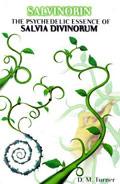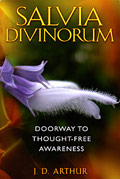Divining the Sage
Book Recommendations for Interpreting the Salvia Enigma
Nov 2010
Citation: Arnson D. "Divining the Sage: Book Recommendations for Interpreting the Salvia Enigma". Erowid Extracts. Nov 2010;18:18-19. Online edition: Erowid.org/library/review/review_article5.shtml
One of the most intriguing developments in the world of psychedelics during the 1990s was the sudden rise in awareness and popularity of the enigmatic plant Salvia divinorum and its psychoactive compound, salvinorin A. Researcher Daniel Siebert was the first to publish on the effects of salvinorin A in a human, after bioassaying crystals he extracted from dried leaf in 1993. Spurred on by trip reports in publications such as The Entheogen Review and on the Internet, use of this once little-known botanical is now a worldwide phenomenon with live plants, leaves, and extracts sold in head shops and online. Its notoriety has caused it to become banned in a few U.S. states and several other countries.
Native only to a small mountainous region of Oaxaca, Mexico, its use has jumped from the sacred (Mazatec Indian healing rituals) to the profane (kids smoking it in YouTube videos, for a laugh). Since the mid-1990s, over a dozen publications focused entirely on the topic of salvia have come out in print; the following reviews describe three of my favorite single-author books about this fascinating plant.
Out-of-print, but archived at: Erowid.org/books_online/salvinorin/
D. M. Turner, late author of The Essential Psychedelic Guide, produced the first slim book on the topic of Salvia divinorum. Thoughtfully and cogently written, Turner takes care to point out potential hazards from using the substance, such as severe-but-temporary disorientation.
Quoting Daniel Siebert, he presents several common reactions to salvia such as the sense of becoming an object; visions of two-dimensional surfaces, films, and membranes; revisiting places from the past; loss of the body and/or identity; various sensations of motion; uncontrollable hysterical laughter; and overlapping realities. Not necessarily what passes for recreation!
Turner provides a brief history of the plant, outlandish trip reports, and descriptions of the effects of salvinorin A combined with other psychedelics. He also touches upon his own encounters with a feminine salvia entity, and makes the interesting observation:
Author Martin Ball holds a PhD in Religious Studies and has been featured in the magazine Shaman's Drum. His book Sage Spirit is an important contribution to the literature, as he has developed a shamanic ritual for the use of Salvia divinorum--one adapted for a contemporary Western approach, as opposed to following the original Mazatec form. While acknowledging that salvia can be "profoundly difficult and challenging to manage", he emphasizes that "ritual is key" to bringing out the power of the plant.
Much of the book is comprised of journal-style descriptions and subsequent analyses of the author's salvia journeys--from his first experience at the Burning Man festival to his years-long evolution of a ceremonial practice--wherein he encounters a realm of other consciousnesses, beings, and intentions.
A central element to shamanism--and to Ball's salvia ritual--is the use of rhythmic, patterned sound. Ball reports great success using (at various times) drumming, rattling, the didgeridoo, and Tuvan-style vocalizations. Although he has released some semi-electronic music CDs, he feels that the best application of sound comes from "organic" instruments. It is fascinating to read his discovery that sound perception in "our" dimension is different from that of salvia space. In "their" dimension, the right rhythmic sounds create three-dimensional architectural structures. Ball proposes that with the correct vibrations, one can do healing through singing. This concept parallels that of the icaros, or healing songs of ayahuasca shaman.
The multifaceted Ball has also done some fantasy fiction writing that is clearly influenced by his entheogenic experiences, and he excerpts passages from those writings in part of this book to show how the mythic can dovetail with altered mind states.
The book concludes with a short section providing thoughtful guidelines on how to conduct a salvia ceremony for groups or for the individual. Ball has done some much-needed shamanic pioneering here, and his ideas on psycho-acoustics bear further investigation.
It has often been said that most folks who try salvia once never feel the need to take it a second time. The books above are notable in that their authors have, with courage and dedication, done some serious "mapping of hyperspace" (as Terence McKenna called it). Salvia has never been, nor should it ever be, considered a "party drug". Hopefully, increased awareness of its less-than-recreational properties will keep it legally available as a true entheogen and shamanic tool.
In reviewing the literature on Salvia divinorum, I would be remiss not to point out the plant's poetic presentation in a chapter of Dale Pendell's book Pharmako/Poeia: Plant Powers, Poisons, and Herbcraft, as this important piece of writing inspired production of the first commercial 5X salvia extracts. Also worth noting is the most comprehensive treatment of the plant currently accessible, the 251-page book Salvia divinorum and Salvinorin A: The Best of The Entheogen Review 1992-2000 (out-of-print, but available at Erowid.org/library/books_online/salvia_divinorum_and_salvinorin_a.pdf). Finally, I am looking forward to the forthcoming release of salvia expert Daniel Siebert's 600+ page tome, Divine Sage: The Definitive Guide to Salvia divinorum.
Native only to a small mountainous region of Oaxaca, Mexico, its use has jumped from the sacred (Mazatec Indian healing rituals) to the profane (kids smoking it in YouTube videos, for a laugh). Since the mid-1990s, over a dozen publications focused entirely on the topic of salvia have come out in print; the following reviews describe three of my favorite single-author books about this fascinating plant.

|
Salvinorin: The Psychedelic Essence of Salvia divinorum
D. M. Turner (Panther Press, 1996)Out-of-print, but archived at: Erowid.org/books_online/salvinorin/
D. M. Turner, late author of The Essential Psychedelic Guide, produced the first slim book on the topic of Salvia divinorum. Thoughtfully and cogently written, Turner takes care to point out potential hazards from using the substance, such as severe-but-temporary disorientation.
Quoting Daniel Siebert, he presents several common reactions to salvia such as the sense of becoming an object; visions of two-dimensional surfaces, films, and membranes; revisiting places from the past; loss of the body and/or identity; various sensations of motion; uncontrollable hysterical laughter; and overlapping realities. Not necessarily what passes for recreation!
Turner provides a brief history of the plant, outlandish trip reports, and descriptions of the effects of salvinorin A combined with other psychedelics. He also touches upon his own encounters with a feminine salvia entity, and makes the interesting observation:
"If there is a physical counterpart to consciousness, memory or identity in humans, and if it could be extracted from our brains, I think we would find something similar to salvinorin. [...] I never actually lose consciousness [...] It's simply that consciousness becomes so vast that I lose the perspective of my individual self."Although this book was written at the beginning of the salvia renaissance, it remains an excellent general treatment on the subject.

|
Salvia divinorum: Doorway to Thought-Free Awareness
by J. D. Arthur (Park Street Press, 2010)"Probably the single most important change in perception that salvia can grant is the understanding of the difference between thought and awareness. [...] Awareness is a silent steady state of what might be called self-acknowledgement. [...] Thought, on the other hand, takes work. One must remember and maintain scores of concepts, buttressed by myriad words, to retain and connect, it seems, even the simplest of thoughts. [...] Salvia can restore, if only for a few moments, our birthright of pure thoughtless awareness that lies quietly beneath the clatter of thought."Originally published in 2008 under the title Peopled Darkness: Perceptual Transformation through Salvia divinorum, this book is based upon a series of experiences the author had over several years. Arthur is able to bypass the bewildering sensory effects of his initial experiences with an articulate analysis and description of a true "relationship" that he develops with the substance, especially with that of a 5X concentrate. He describes mental states in which he encounters "pockets of eternity", and states that offer him access to realms where other beings exist. In innately self-aware forays through the internal logic of the dream state, he describes having frequent communications with a non-morbid "land of the dead", or spirit world. Arthur also has much to say on the subject of language in the "salviaic" state, where English becomes superfluous and cumbersome, ultimately changing to a completely different yet still auditory form. Hinting at an almost Castaneda-style cosmology, this is a wonderfully written book. I truly appreciated Arthur's ability to convey some very esoteric thought processes in a concrete manner.

|
Sage Spirit: Salvia divinorum and the Entheogenic Experience
by Martin W. Ball (Kyandara, 2007)Author Martin Ball holds a PhD in Religious Studies and has been featured in the magazine Shaman's Drum. His book Sage Spirit is an important contribution to the literature, as he has developed a shamanic ritual for the use of Salvia divinorum--one adapted for a contemporary Western approach, as opposed to following the original Mazatec form. While acknowledging that salvia can be "profoundly difficult and challenging to manage", he emphasizes that "ritual is key" to bringing out the power of the plant.
Much of the book is comprised of journal-style descriptions and subsequent analyses of the author's salvia journeys--from his first experience at the Burning Man festival to his years-long evolution of a ceremonial practice--wherein he encounters a realm of other consciousnesses, beings, and intentions.
A central element to shamanism--and to Ball's salvia ritual--is the use of rhythmic, patterned sound. Ball reports great success using (at various times) drumming, rattling, the didgeridoo, and Tuvan-style vocalizations. Although he has released some semi-electronic music CDs, he feels that the best application of sound comes from "organic" instruments. It is fascinating to read his discovery that sound perception in "our" dimension is different from that of salvia space. In "their" dimension, the right rhythmic sounds create three-dimensional architectural structures. Ball proposes that with the correct vibrations, one can do healing through singing. This concept parallels that of the icaros, or healing songs of ayahuasca shaman.
The multifaceted Ball has also done some fantasy fiction writing that is clearly influenced by his entheogenic experiences, and he excerpts passages from those writings in part of this book to show how the mythic can dovetail with altered mind states.
The book concludes with a short section providing thoughtful guidelines on how to conduct a salvia ceremony for groups or for the individual. Ball has done some much-needed shamanic pioneering here, and his ideas on psycho-acoustics bear further investigation.
It has often been said that most folks who try salvia once never feel the need to take it a second time. The books above are notable in that their authors have, with courage and dedication, done some serious "mapping of hyperspace" (as Terence McKenna called it). Salvia has never been, nor should it ever be, considered a "party drug". Hopefully, increased awareness of its less-than-recreational properties will keep it legally available as a true entheogen and shamanic tool.
In reviewing the literature on Salvia divinorum, I would be remiss not to point out the plant's poetic presentation in a chapter of Dale Pendell's book Pharmako/Poeia: Plant Powers, Poisons, and Herbcraft, as this important piece of writing inspired production of the first commercial 5X salvia extracts. Also worth noting is the most comprehensive treatment of the plant currently accessible, the 251-page book Salvia divinorum and Salvinorin A: The Best of The Entheogen Review 1992-2000 (out-of-print, but available at Erowid.org/library/books_online/salvia_divinorum_and_salvinorin_a.pdf). Finally, I am looking forward to the forthcoming release of salvia expert Daniel Siebert's 600+ page tome, Divine Sage: The Definitive Guide to Salvia divinorum.

